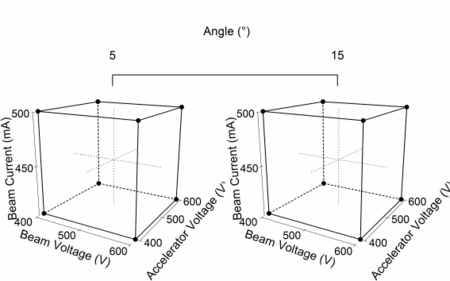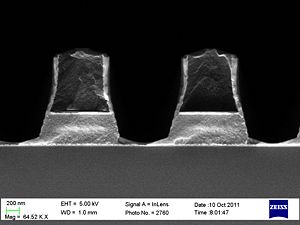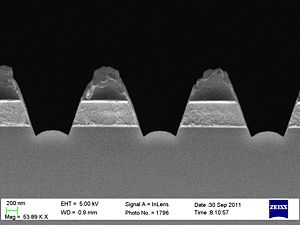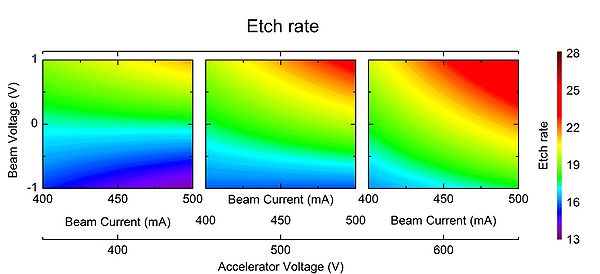Specific Process Knowledge/Etch/IBE⁄IBSD Ionfab 300/IBE magnetic stack etch: Difference between revisions
| (66 intermediate revisions by 3 users not shown) | |||
| Line 1: | Line 1: | ||
== | '''Feedback to this page''': '''[mailto:plasma@nanolab.dtu.dk?Subject=Feed%20back%20from%20page%20http://labadviser.nanolab.dtu.dk/index.php/Specific_Process_Knowledge/Etch/IBE%E2%81%84IBSD_Ionfab_300/IBE_magnetic_stack_etch click here]''' | ||
<br> '''''The work on this page was done Kristian Hagsted Rasmussen, DTU Nanolab, unless otherwise stated''''' | |||
=Etching magnetic stacks= | |||
Magnetic stacks can be etched or more precisly milled in the Ion Beam Etcher (IBE). Below is presented some work done on milling stacks of magnetic layers. | |||
===Process parameters | |||
{| border="2" cellspacing="2" cellpadding="3" | ==Results of Design of Experiments optimization of magnetic stack etching (Kristian Hagsted Rasmussen@nanotech.dtu.dk spring 2011)== | ||
===Process parameters=== | |||
To find the optimal parameters, Design of Experiments was applied with the intervals shown on the figure below. The final optimized recipe is listed in the table. | |||
{| align=left border="2" cellspacing="2" cellpadding="3" | |||
!Parameter | !Parameter | ||
! | !Optimized etch | ||
!DoE low value | |||
!DoE high value | |||
|rowspan="11"|[[image:KHARA-MLS-DoE.png|450x450px|thumb|center|Design of Experiments setup used to find optimal etch of the multi layers stack. Centerpoints are not shown on the figure. The parameters varied were Beam current, Beam Voltage, Accelerator Voltage, and Incident Angle.]] | |||
|- | |- | ||
|Neutalizer current [mA] | |Neutalizer current [mA] | ||
|450 | |450 | ||
|450 | |||
|550 | |||
|- | |- | ||
|RF Power [W] | |RF Power [W] | ||
|800 | |800 | ||
| - | |||
| - | |||
|- | |- | ||
|Beam current [mA] | |Beam current [mA] | ||
|400 | |400 | ||
|400 | |||
|500 | |||
|- | |- | ||
|Beam voltage [V] | |Beam voltage [V] | ||
|500 | |500 | ||
|400 | |||
|600 | |||
|- | |- | ||
|Beam accelerator voltage | |Beam accelerator voltage | ||
|500 | |500 | ||
|400 | |||
|600 | |||
|- | |- | ||
|Ar flow to neutralizer [sccm] | |Ar flow to neutralizer [sccm] | ||
|5.0 | |5.0 | ||
| - | |||
| - | |||
|- | |- | ||
|Ar flow to beam [sccm] | |Ar flow to beam [sccm] | ||
|10.0 | |10.0 | ||
| - | |||
| - | |||
|- | |- | ||
|Rotation speed [rpm] | |Rotation speed [rpm] | ||
|20 | |20 | ||
| - | |||
| - | |||
|- | |- | ||
|Stage angle [degrees] | |Stage angle [degrees] | ||
|5 | |5 | ||
|5 | |||
|15 | |||
|- | |- | ||
|Helium backside cooling [Torr] | |Helium backside cooling [Torr] | ||
|37.5 | |37.5 | ||
| - | |||
| - | |||
|- | |- | ||
|} | |} | ||
<br clear="all"/> | |||
===Some SEM profile images of the etched stacks=== | ===Some SEM profile images of the etched stacks=== | ||
{| border="1" cellspacing="1" cellpadding="2" | {| border="1" cellspacing="1" cellpadding="2" | ||
| | |||
[[image:IBE magnetic stack A19-13.jpg|300x300px|thumb|center|Magnetic stack of Ta/MnIr/NiFe/Ta/Tao/Ta/MnIr/NiFe/Ta. Redeposition of etched material at photo resist. Profile ~78°]] | [[image:IBE magnetic stack A19-13.jpg|300x300px|thumb|center|Magnetic stack of Ta/MnIr/NiFe/Ta/Tao/Ta/MnIr/NiFe/Ta etched with the optimal parameters shown above. Redeposition of etched material at photo resist. Profile ~78°]] | ||
| | |||
[[image:IBE magnetic stack A16-13.jpg|300x300px|thumb|center|Etched magnetic stack with | [[image:IBE magnetic stack A16-13.jpg|300x300px|thumb|center|Etched magnetic stack with poor structure transfer, the parameters chosen was clearly not optimal. Chosen etch parameters result in severe footing]] | ||
| | |||
[[image:IBE magnetic stack A3-13.jpg|300x300px|thumb|center|Etched magnetic stack with | [[image:IBE magnetic stack A3-13.jpg|300x300px|thumb|center|Etched magnetic stack with poor structure transfer, the parameters chosen was clearly not optimal. Chosen etch parameters result in severe trenching]] | ||
|} | |} | ||
For a good pattern transfer with IBE a large amount of redeposition on the resist edge has been observed. To reduce this redeposition the best option seems to be to use a photo resist just thick enough for the wanted etch depth. An alternative is sidewall sputtering at low incident angle. However experiments have shown poor cleaning rate and for narrow structures low angles will give rise to shadowing effects. | |||
===Endpoint detection with SIMS=== | ===Endpoint detection with SIMS=== | ||
{| border="1" cellspacing="1" cellpadding="2" | |||
|[[image:SIMS_end_point_detection.png|300x300px|thumb|center|The endpoint for etching is determined by the integrated SIMS]] | |||
|} | |||
End point detection is achieved by SIMS, and the etch rate is approximately 25 Nm/min. | |||
===Problems with resists stripping after etching=== | |||
Resist stripping after the etch can be hard due to burned resist, to remedy this try to lower the current. Changing the current will change the sidewall angle and new studies of etch profiles will be necessary. For help, discussion and further info please contact the dry etch group [mailto:dryetch@nanolab.dtu.dk]. | |||
===Design of Experiment results=== | |||
The etch rate and corner angle are dependent on several parameters each. Below two graphs showing these dependencies are shown. Note that the values are fitted and may not represent the actual value after etch, however feel free to use the graphs to estimate the values for your test run. | |||
{| border="1" cellspacing="1" cellpadding="2" | |||
|[[image:IBE magnetic DoE etch rate.jpg |600x300px|thumb|center|The etch rate did not show any dependency on incident angle. The shown results are fitted to the DoE data and may not give an accurate measure of etch rate.]] | |||
|[[image:IBE magnetic DoE Corner Angle.jpg|300x300px|thumb|center|The corner angle for the etch samples showed a dependency on all parameters. The general trends can be found from the plot, however for etch structures the resultant angle may differ.]] | |||
|} | |||
===Conclusions=== | |||
* Etch rate around 20 nm/min with optimized recipe. | |||
* Good feature definition after etch. | |||
* Good end point detection by SIMS. | |||
* Burned resist: Lower current, 300 mA can limit resist burning. Note this <b>will</b> affect pattern transfer. | |||
* Hare ears (also called fences) due to redeposition, thinner resist can limit the size. | |||
Latest revision as of 10:27, 4 September 2025
Feedback to this page: click here
The work on this page was done Kristian Hagsted Rasmussen, DTU Nanolab, unless otherwise stated
Etching magnetic stacks
Magnetic stacks can be etched or more precisly milled in the Ion Beam Etcher (IBE). Below is presented some work done on milling stacks of magnetic layers.
Results of Design of Experiments optimization of magnetic stack etching (Kristian Hagsted Rasmussen@nanotech.dtu.dk spring 2011)
Process parameters
To find the optimal parameters, Design of Experiments was applied with the intervals shown on the figure below. The final optimized recipe is listed in the table.
Some SEM profile images of the etched stacks
For a good pattern transfer with IBE a large amount of redeposition on the resist edge has been observed. To reduce this redeposition the best option seems to be to use a photo resist just thick enough for the wanted etch depth. An alternative is sidewall sputtering at low incident angle. However experiments have shown poor cleaning rate and for narrow structures low angles will give rise to shadowing effects.
Endpoint detection with SIMS
 |
End point detection is achieved by SIMS, and the etch rate is approximately 25 Nm/min.
Problems with resists stripping after etching
Resist stripping after the etch can be hard due to burned resist, to remedy this try to lower the current. Changing the current will change the sidewall angle and new studies of etch profiles will be necessary. For help, discussion and further info please contact the dry etch group [1].
Design of Experiment results
The etch rate and corner angle are dependent on several parameters each. Below two graphs showing these dependencies are shown. Note that the values are fitted and may not represent the actual value after etch, however feel free to use the graphs to estimate the values for your test run.
Conclusions
- Etch rate around 20 nm/min with optimized recipe.
- Good feature definition after etch.
- Good end point detection by SIMS.
- Burned resist: Lower current, 300 mA can limit resist burning. Note this will affect pattern transfer.
- Hare ears (also called fences) due to redeposition, thinner resist can limit the size.






